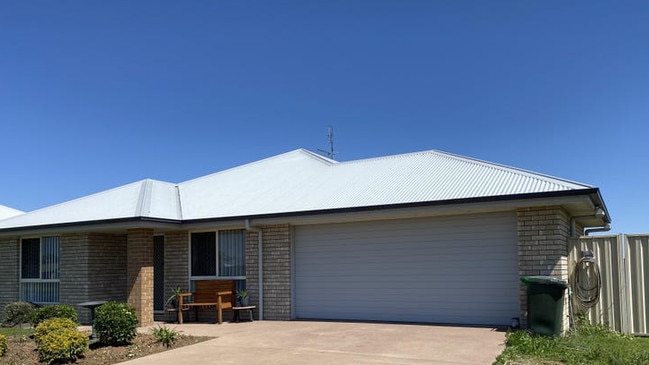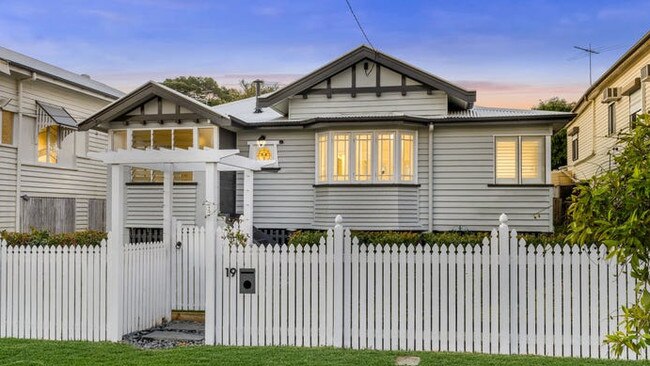Qld suburbs where landlords have fled the market
A huge percentage of homes for sale in each of these investor hotspots has been ripped from the rental pool over the past year.

Property
Don't miss out on the headlines from Property. Followed categories will be added to My News.
The Queensland suburbs where landlords have fled the market in the past year have been revealed, with more than one third of homes for sale in each investor hotspot ripped from the rental pool.
Exclusive data by SuburbTrends shows the locations with the highest percentage of ex-rental property listings over the 12 months to June, exacerbating the state’s chronic housing shortage and plunging many tenants into extreme rental pain.

SuburbTrends’ top 10 postcode ranking covers suburbs across Brisbane and the regions, with sales by investors accounting for 35 per cent of homes listed in Kedron and Gordon Park in the city’s north, as well as the inner pockets of Kelvin Grove and Red Hill.
The proportion of ex-rental listings soared to more than 40 per cent in the outback markets of Roma, Hodgson, and Moranbah, while investors also exited the Greater Brisbane growth areas of Logan, Woodridge, and Kingston.
Punitive legislative reforms and the soaring cost of living were key reasons for the landlord exodus.
Yet the Sunshine State retained its shine for a new breed of cashed-up buyers eyeing the next boom, as the upcoming 2032 Olympics and strong interstate migration underpin growth prospects.

SuburbTrends analyst Kent Lardner said the sell-off in some suburbs meant the loss of critical rental stock at a time when more housing was urgently needed.
“We need the rental pool to be expanding, not getting smaller,” he said.
Mr Lardner said offloading assets had become a “survival strategy” for negatively geared investors who bought 3-4 years ago and were therefore most exposed to rate hikes.
“Negative gearing makes sense if your investments are profitable but it becomes a lot less attractive when you’re digging deep into your own pocket each month to pay for an investment.
“We know many of these investors bought thinking rates wouldn’t go up. It was something the Reserve Bank had even said at the time, so it’s no surprise that it caught a lot of people short.”

He said the portrayal of investors as “robber barons” was flawed, with a shortage of housing rather than landlord greed the key driver of rent price increases.
“Most landlords in this country are mum-and-dad type investors. Some are even rentvesters, so they rent themselves, and they’re exposed to the same cost of living issues as everyone else.”
It was likely some investors who cashed out of the market in recent months had pushed the margins of what they could borrow back in 2020 and 2021, when rates were at record lows.
The low interest rate environment coincided with a boom in prices that was part of what compelled investors to borrow more.
SuburbTrends research highlighted ongoing challenges in the housing market, with tenants in more than 80 per cent of Queensland’s suburbs potentially under rental stress – when more than 30 per cent of the household budget was needed to cover rent.
“The substantial number of ex-rental properties not being replenished suggests that the rental market in these areas will face increased pressure,” Mr Lardner said.
“This could lead to higher rental prices and reduced availability of rental properties, exacerbating the rental crisis in these postcodes.”

MORE NEWS
Six capital city rentals under $350 a week
State of Origin great lists dream home build
Rent crisis: ‘Good news’ for tenants despite grim outlook
Property Investment Professionals of Australia (PIPA) chair Nicola McDougall said rental reforms introduced in Queensland over the past 12 months had been another blow for landlords already struggling in a higher interest environment.
“With the gap between weekly rents and mortgage repayments now significant, many investors simply cannot continue to manage the negative cash flow and are selling one or more of their investment properties to reduce their borrowings,” Ms McDougall said.
“The recent retrospective annual rent increase limits on property was yet another anti-investor reform that is encouraging more investors to exit the market.”

PIPA’s 2023 Annual Investor Sentiment Survey found investors had sold in Queensland more than any other state in the previous 12 months, with 40 per cent of respondents selling at least one dwelling in the Sunshine State in that time.
“The main reasons why they had sold – and are continuing to sell – included changing tenancy legislation impacting the control of their assets as well as increasing their compliance and holding costs, and governments increasing or threatening to increase property taxes, which makes property a less attractive asset to hold.”
Ms McDougall said the government needed to, “stop forever changing the goal posts for property investors”.
“Investors deserve policy stability given they are purchasing properties that come with 30-year mortgages.
“The past decade has seen such a raft of rental reforms in Queensland that have achieved very little – apart from encouraging investors to exit the market and dissuading others to enter it.
“The rental crisis in Queensland is set to be more severe and prolonged than it needed to be because of the continual market intervention by poorly educated policymakers chasing popularity over anything else,” she said.

Rethink Investing manager director Scott O’Neill said Queensland remained a “prime focus for property investors”, with interest particularly high among interstate professionals and retirees.
“Investors are drawn to Brisbane for its relative affordability, good yields, and strong capital growth prospects,” Mr O’Neill said, adding the volume of clients considering investing in the city had spiked by 40 per cent since 2015.
“Queensland’s preparation for the 2032 Olympics, strategic goals, extensive infrastructure development, and high interstate migration rates make it a prime focus for property investors,” he said.
“The state’s proactive approach to urban planning and economic development ensures a fertile environment for investment across residential, commercial and industrial sectors, promising both short-term gains and long-term stability.”

An uptick in investor activity last month underpinned a slight rise in Queensland’s rental vacancy rate.
PropTrack’s Market Insight Report released this week showed the number of available homes increased by 0.05 percentage points to 1.2 per cent in Brisbane, and 1.26 per cent in regional Queensland.
But vacancy remained about 45 per cent down since the start of the pandemic in March 2020.
PropTrack senior economist Anne Flaherty said a “chronic undersupply of rental properties” was likely to continue over the next few years as housing development failed to keep pace with population growth.

Top 10 Postcodes with Ex-Rental Properties Listed for Sale in FY 2024 (QLD)
Postcode/Suburbs/Ex-Rental Percentage
4455/Roma, Hodgson/43%
4744/Moranbah/41%
4031/Kedron, Gordon Park/35%
4717/Blackwater/35%
4059/Kelvin Grove, Red Hill/34%
4114/Logan Central, Woodridge, Kingston/34%
4815/Rasmussen, Kelso, Condon, Gumlow34%
4413/Chinchilla, Canaga/33%
4680/Boyne Island, Clinton, Kin Kora, New Auckland, Tannum Sands, Gladstone/32%
4811/Oonoonba, Wulguru, Idalia, Cluden, Stuart, Oak Valley/32%
* source: SuburbTrends
Originally published as Qld suburbs where landlords have fled the market


